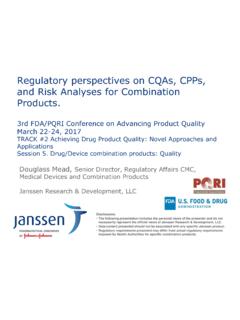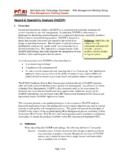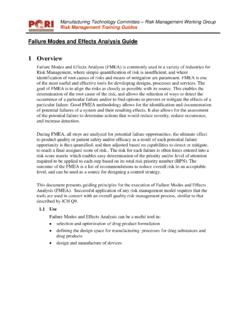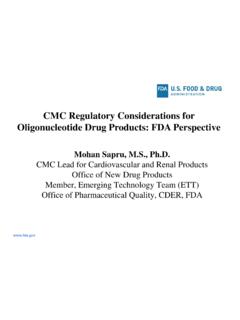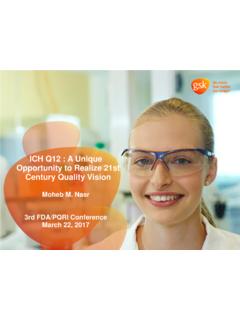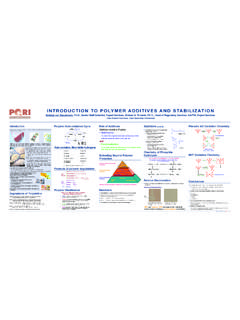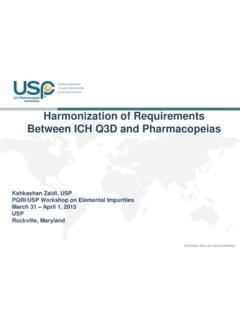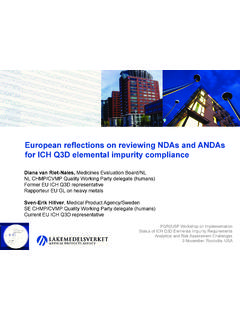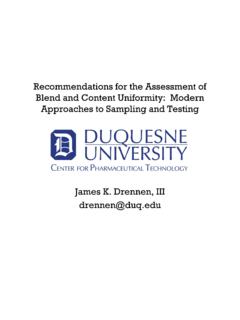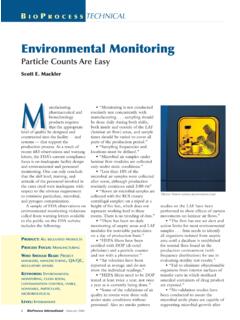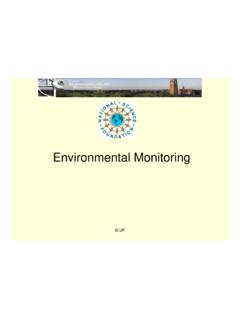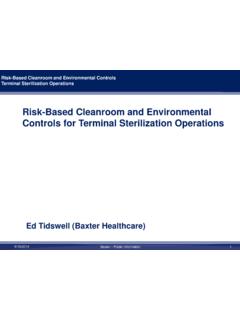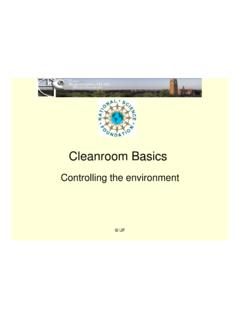Transcription of Risk-based Environmental Monitoring - PQRI
1 Risk-based Environmental Monitoring Marsha Stabler Hardiman Senior Consultant Concordia ValSource Wednesday September 17, 2014 FDA/PQRI Presenter Marsha Stabler Hardiman Over 20 years experience in the Pharmaceutical and Medical Device industries Microbiologist/EM Expert Senior Consultant, Concordia ValSource LLC Quality By Design for Sterile Product Manufacturing Risk based EM Environmental Monitoring (EM) is Evolving Not the same EM Programs of the past Sterile Manufacturing Critical Quality Attribute (CQA) Absence of biological contamination EM is a detection tool to help us achieve this CQA Novel Approach to Environmental Monitoring Value added and Risk based EM Programs cGMP expectation Presentation Outline Definitions Environmental Monitoring (EM) Regulations room Classifications -EM Program Misconceptions Risk-based EM Risk Assessment Tool Media Equipment Incubation and Data Collection Microbial IDs What is Environmental Monitoring ?
2 Sampling of controlled environments for non-viable and viable air particulates as well as surface viables Allows for assessment of effectiveness of cleaning/disinfection Allows for identification of trends Facilitate early detection of potential problems What is Risk based EM? Application of QRM tools and approaches into your EM Program design and throughout the product lifecycle Understanding your products and processes Understanding your microbial contamination risks Ensuring that proper risk mitigations are in place to help prevent contaminations Ensuring that EM sample sites selection and sampling frequencies reflect this understanding and are properly established to best detect potential contamination You are the expert in your products and processes your EM Program should reflect this knowledge Regulations/Guidance ISO 14644-1 Cleanrooms and Associated Controlled Environments - Part 1.
3 Classification of Air Cleanliness , 1999 USP 1116 Microbiological Control and Monitoring of Aseptic Processing Environments USP 1115 Bioburden Control of Nonsterile Drug Substances and Products FDA Aseptic Processing Guideline EU Annex 1 Japan Aseptic Processing Guide and JP AAMI TIR 52 Environmental Monitoring for the Manufacture of Terminally Sterilized Healthcare Products Medical Device Design and Construction of Cleanrooms - room Classification ISO 14644 assigns ISO classification levels to be used for the specification of air cleanliness in cleanrooms and associated controlled environments Healthcare ISO 5 -8 Classification defined per ISO 14644-1 level (or the process of)
4 Specifying or determining the level) of airborne particulate cleanliness applicable to a cleanroom or clean zone, expressed in terms of an ISO Class N, which represents maximum allowable concentrations (in particles per cubic meter of air) for considered sizes of particles Airborne Particulate Cleanliness Classes ISO Class m m ISO 5 3,520 29 ISO 6 35,200 293 ISO 7 352,000 2,930 ISO 8 3,520,000 29,300 Maximum concentration limits (particles > or 5 um/m3 of air) ISO 14644-1 maximum allowable particle concentrations Airborne particulate cleanliness shall be designated by a classification number Definitions of room Occupancy States as-built condition where the installation is complete with all services connected and functioning but with no production equipment, materials, or personnel present at-rest condition where the installation is complete with equipment installed and operating in a manner agreed upon by the customer and supplier, but with no personnel present operational condition where the installation is functioning in the specified manner.
5 With the specified number of personnel present and working in the manner agreed upon The particulate cleanliness of air in a cleanroom shall be defined in one or more occupancy states and the considered particle size shall be stated Common Misperception with ISO 14644 B - Minimum number of sample point locations based on formula: NL = A (NL = (square root) of A) NL is the minimum number of sampling locations (rounded up to a whole number) A is the area of the cleanroom or clean zone in square meters. room grid based on room area Specific to nonviable particulate sample locations for cleanroom classification evaluates air quality against design not routine EM Establishment of Qualification Study EM Sampling Plan and Sites ISO 14644 grid approach for room classification During initial startup, locations for air and surface Monitoring determined Locations should include those in close proximity to exposed product.
6 Product contact surfaces Prospective risk analysis shall be performed to develop a rationale for the sampling locations and frequencies Not all rooms of the same ISO Class need the same control levels Avoid over sampling as well as under sampling focus on reduction of contamination sources Walls and Floors USP <1116> Microbiological Control and Monitoring of Aseptic Processing Environments Significant changes made to USP <1116> in late 2012 This Chapter is NOW specific to EM of aseptic processing environments Sterile products, bulk sterile drug substances, sterile intermediates, excipients, medical devices ( , contact lens solutions) Risk based sample locations and frequencies with documented rationale Table 2 suggests sampling frequency aseptic processing areas Rate of occurrence of excursions in place of CFU levels Contamination Recovery Rates percentage of plates showing any microbial recovery regardless of the number of CFU for each cleanroom (Table 3)
7 Action levels should be based on empirical process capability If exceed, Table 3 or process capability levels, take corrective action ISO 5 excursions > 15 CFU single sample, significant excursion USP <1115> Bioburden Control of Nonsterile Drug Substances and Products Describes Microbial Assessment of Non-sterile Product Manufacturing Environments Part of Risk-based Microbiological Control Program Contamination Recovery Rates from <1116> are not intended for non-sterile environments Contamination likely depends on level of human activity and levels of gowning Sampling locations should be selected based on risk evaluation Frequency of Monitoring should reflect the potential risk associated with the dosage form Products that are resistant to microbial contamination require little to no Monitoring EM Program s of the Past Viable and
8 Non-Viable Center of the room Surface Viable Center of Each Wall Floor - corner of each room , center of room IS THIS WRONG? IS THIS RISK based ? EM Program Risk-based Approach Two way approach similar but different based on prior knowledge: 1 New EM Program 2 Reassessment of Current/Existing EM Program New EM Program New Facility? New Controlled Environment additions to existing facility? Any Prior Knowledge contamination types and levels? Prior knowledge is an input Assess Microbial Risk of New Area Product Type Process Step 1 - Planning Risk Management Planning Determine Team/Members cross functional (Micro, QA, MFGing, Facilities, Engineering) Select Facilitator not bias to activity Define Scope of Risk Activities for EM Program assessment Determine the Risk Management Tools to be used Determine Scoring to be used company procedure may already exist Determine Communication of Risk Plan Who needs to be communicated to, when, how often, how much detail Impact to Regulatory Filings Costs Step 2 - Assess Activity Affecting Microbial State of Control Brainstorm Fishbone Cross functional team Microbiologists, Manufacturing, Engineers, Quality.
9 Facilities May want to break down by sub-teams for different rooms if large facility No need to discuss current controls in place at this point Simply identifying all areas of microbial risk MICROBIAL CONTROL MATERIALS MACHINE MOTHER NATURE CAUSES OF MICROBIAL CONTAMINATION Floods Power Outages HVAC EQ 2 EQ 1 Behavior Batch Records Gowning Materials METHODS MAN (HUMAN) Gowning Awareness Raw Materials Training Airlocks Sinks Fires Utilities Hoses Carts/Cart Wheels Charging Vessel Cleaning Agents/Supplies Raw Material Weighing/Dispensing Cleaning Tablet Coating Washers Step 3 - Assess Activity and Flow Gemba (go see) walk each room /area if possible If construction phase.
10 Do via paper until you can get in the area Best case - Work with engineers prior to design and construction start to identify microbial risk points and plan them OUT Assess planned personnel flow Assess planned material flow Sample site locations should be based on risk of activity Likelihood of contamination from process Open or Closed Process People likely largest contributors of room contamination if closed process Maybe you have a wet process Gram negatives Contamination from other products Step 4 Perform Risk Assessment Next use the information obtained in the brainstorming activity and floor assessment as a foundation to perform a risk assessment Include known controls and risk mitigations Cross functional team Microbiologists, Manufacturing, Engineers, Quality, Facilities Preliminary Hazard Analysis (PHA) or Failure Modes and Effects Analysis (FMEA) FMEA Process Example Identify Hazards Example: Not meeting Air Quality Viable EM Levels Identify Harms Example: Airborne contamination in controlled environment Identify Hazardous Conditions Contamination of room EQ Contamination of product contact surfaces Contamination of People Contamination of work surfaces Determine Severity, Occurrence and Detection Scores Determine Risk Priority Number (RPN) Determine Control Measures in Place Example.
